Homemade food is a great expression of love for your pet cat. Fresh meat, preservative-free ingredients—everything may sound good. But the problem is, many times these foods cannot provide all the nutrients your cat needs. And this is where “homemade cat food premix” plays an important role.
These special premixes are made in such a way that nutritional deficiencies can be filled when mixed with home-cooked or raw meat. These premixes prepared according to standards like AAFCO or FEDIAF are helpful in protecting your cat’s health.
In this blog, we discussed how to choose a good premix, which ingredients are essential and why it is safest to use premixes prepared as advised by professionals. If you really want to ensure the long-term well-being of your cat, then this article is for you.
Table of Content
- Homemade Cat Food Recipe: Chicken & Pea for Caturday
- A Quick Note on Nutritional Balance
- How to Evaluate Homemade Cat Food Recipes
- 5 Sample Recipes for Homemade Cat Food
Homemade Cat Food Recipe: Chicken & Pea for Caturday
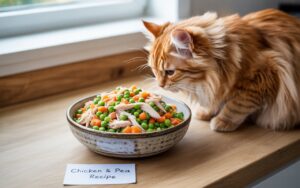
Hello dear cat lovers! Today is Caterday! And it’s time to make your beloved cat’s day special, with a bowl of delicious and nutritious homemade food.Today we will be making a super easy, healthy and cat-friendly chicken and pea recipe, which my very own food critic “Tito” also ate with joy!
Chicken & Pea Delight: A Purr-fect Homemade Cat Food
Prep Time: 15 minutes
Cook Time: 25 minutes
Servings: 1–2 meals
(Time may vary if using frozen ingredients)
Ingredients:
- 200g (7oz) Chicken (fresh or frozen)
- 100g (3.5oz) Peas (fresh or pre-cooked)
- 1 tablespoon Salmon oil (or olive oil as an alternative)
Instructions:
- Cook the Chicken
If frozen, defrost it first. Then cook thoroughly — no pink or raw spots. Your cat’s digestive system will appreciate it. - Prepare the Peas
Cook fresh peas alongside the chicken, or use pre-cooked peas and set them aside. - Blend or Chop
Once everything’s cooked, chop the chicken and peas finely or blend lightly for a soft, easy-to-digest texture.
Why This Recipe Works
- Simple & Quick – Takes under 30 minutes.
- Nutritious – Packed with lean protein and essential fatty acids.
- Cat-Approved – Tested and loved by Tito!
Treat your cat to a Caturday they’ll actually look forward to — full of flavor, nutrients, and tail wags (or purrs). ❤️
A Quick Note on Nutritional Balance
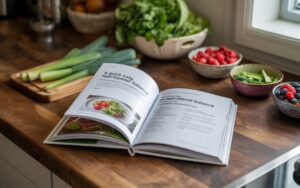
Although this recipe for homemade cat food is enjoyable and healthy, keep in mind:
- Cats are obligate carnivores, indicating that their diet must mainly consist of meat.
- This recipe serves as an additional dish or snack, rather than a full diet.
- To create a completely balanced homemade diet, seek advice from a veterinarian or pet nutritionist.
Your feline’s well-being and joy are paramount, so make sure they receive all necessary nutrients!
How to Evaluate Homemade Cat Food Recipes

Before we get to the recipes, it’s important to clarify one important thing — homemade cat food is not suitable for all cats or cat owners. It can be a great option in some cases, but you should definitely consult your vet before you start. He or she will understand your cat’s health best and will be able to guide you through the process to ensure that there are no nutritional deficiencies.
In our experience, while many homemade cat food recipes on the internet may look great, they are not always nutritionally balanced. Yes, many recipes contain adequate animal protein, but essential vitamins and minerals are missing or unbalanced.
When you’re checking out recipes online, here are a few red flags to watch out for:
- The recipe wasn’t created by a vet nutritionist or someone who understands feline nutrition.
- There’s no info on nutrient content or whether the recipe meets AAFCO standards.
- It’s overly simple — like just meat and veggies with no mention of supplements.
- It doesn’t explain how much to feed based on your cat’s weight or calorie needs.
- It says the food is for “supplemental feeding only,” not for everyday meals.
Unless you’re trained in animal nutrition, we strongly recommend following trusted recipes rather than trying to make one from scratch. Getting the right balance of nutrients is tricky — and it really matters for your cat’s long-term health.
The good news? There are safe, vet-backed supplements out there that can make this easier. Keep reading — we’ll show you a product that can help you do homemade the right way.
5 Sample Recipes for Homemade Cat Food
1. Turkey Breast and Sweet Potato Recipe
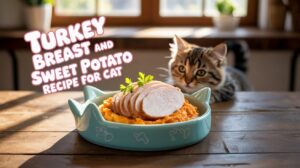
If you’re serious about feeding your cat homemade food the right way, Balance.it is a name you’ll want to know. It’s a U.S.-based company that’s been around since 2003, created by Dr. Sean Delaney — a board-certified veterinary nutritionist. Their focus? Making balanced homemade pet food easier and safer for pet parents like us.
I personally used the Balance.it Recipe Builder to create a custom meal plan for a healthy, 5-year-old neutered male cat weighing 10 pounds. Out of the options, I picked the high-protein, low-carb recipe — great for energy and muscle health.
The recipe yields about 170 grams of food and contains 265 calories, perfect for one or two meals depending on your cat’s needs.
Ingredients I Used:
- 3⅜ oz (96g) cooked turkey breast – plain, no skin or seasoning
- 1⅝ tsp (7g) canola oil – a healthy fat source
- 0.37g Nordic Naturals Omega-3 liquid – for skin, coat, and inflammation support
- 5/16 cup (63g) baked sweet potato – gentle fiber and carbs
- ⅛ tsp (0.75g) iodized salt – small but essential
- ¾ tsp (3.07g) Balance IT Carnivore Blend – a supplement mix to complete the recipe
How I Made It:
- Roast the turkey breast at 350°F (about 175°C) until fully cooked (internal temp should hit 165°F).
- Bake the sweet potato alongside the turkey until soft.
- Scoop out the sweet potato flesh and weigh out the right amount.
- Chop the turkey finely, then weigh your portion.
- Mix turkey and sweet potato in a bowl.
- Add the supplements — Balance IT powder, oil, and salt — and stir well.
- Serve one meal fresh, and store the rest in the fridge in an airtight container.
💡 Pro Tip: You can batch-cook the turkey and sweet potato ahead of time. Just portion them and freeze the extras. Only add the supplements when you’re ready to serve — this keeps the nutrients fresh and effective.
Nutritional Breakdown (per batch):
- Protein: 113.4g
- Fat: 36.8g
- Carbs: 48.8g
- Fiber: 7.8g
- Ash (minerals): 7.6g
- Calories: 265 kcal
- Caloric Distribution:
- Protein: 47.7%
- Fat: 32.6%
- Carbs: 19.7%
- Moisture: 66.0%
Note:
This kind of balanced recipe gives you peace of mind — your cat’s getting everything they need, with none of the mystery ingredients in commercial food. As someone who’s explored homemade options for years, I can say: working with trusted tools like Balance.it makes all the difference. Freeze any extra you won’t use in 3-4 days.
2. Raw Ground Rabbit Recipe
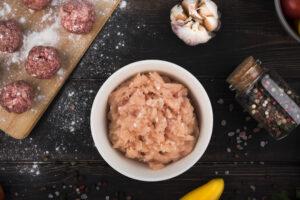
Alnutrin premix supplements are produced by Alternative Nutrition, LLC. Founded in 2008 by Marta Kaspar, the company operates out of the United States. Alnutrin provides a limited range of supplements and three premixes designed based on AAFCO nutrient standards. Two premixes include calcium for use with boneless meat, while the third is designed for homemade recipes featuring meat, organs, and bone.
Due to one of my cats having food allergies, I provide them both with a rabbit-based store-bought diet, but I have been interested in making homemade cat food. I chose Alnutrin’s Meat & Bone premix as it is tailored for use with whole rabbit or chicken (including bones and organs).
Ingredients I Used:
- 1 pack (4g) Alnutrin for Meat & Bone
- ¼ cup (60g) water
- 1 lb (454g) ground raw rabbit meat, bones, and organs
How I Made It:
- I started by trimming the rabbit meat off the carcass and cutting it into small chunks (about 1-inch pieces).
- Then, I crushed the bones into smaller parts so they’d fit into my meat grinder.
- I ground up the meat, bones, and organs all together in a bowl.
- In a separate bowl, I mixed the Alnutrin powder with water until it dissolved.
- I stirred that mixture into the ground meat blend, portioned it out, and froze it.
Nutritional Breakdown:
Dry Matter:
- Protein: 65.3%
- Fat: 15.7%
- Ash: 3.44%
- Carbs: 0%
As Fed (per 100g):
- Protein: 13.5g
- Fat: 3.24g
- Fiber: 0g
- Ash: 0.71g
- Moisture: 3g
Notes:
This premix is made to work with a full combination of meat, bones and organs. If your rabbit meat doesn’t come with organs included, you’ll need to get those separately or consider a different premix that fits your needs.
For me, using Alnutrin gave me peace of mind. I knew I wasn’t just guessing the recipe was designed with nutrition in mind. It helped me take that first confident step into homemade feeding and both of my cats are loving it so far.
3. Cooked Meat Recipe

Food Fur Life is a company in the United States that provides homemade supplements for pet food. The EZComplete Premixes from the brand are crafted using human-grade ingredients and produced in a facility that is registered and inspected by the FDA. EZComplete for Cats needs only boneless meat and water. Pet owners can choose to provide the food raw, or they may cook the meat prior to mixing in the premix.
Food Fur Life advises using lean proteins such as turkey breast, chicken thigh, or pork loin alongside EZComplete Fur Cats. I decided to make a cooked variation of this recipe using ground beef that I had available. To lower the fat content, I removed the fat after preparing the beef.
Ingredients I Used:
- 2 lbs. (907g) ground meat, cooked
- ½ cup (53.3g)
- 1 ½ cups (12 oz.) water
How I Made It:
- Place the ground meat in a slow cooker.
- Add ¼ cup of water per pound of meat then cover the cooker with the lid.
- Cook on low heat for 4-6 hours until the meat is cooked through.
- Let the meat cool then shred or finely chop it into bite-sized pieces.
- Stir in the EZComplete until it is thoroughly mixed in.
- Divide the mixture into individual portions—try to divide the cooking juices as evenly as possible.
- Refrigerate or freeze the portions in airtight containers and feed as desired.
Nutritional Breakdown:
- Protein: 85%
- Fat: 11%
- Fiber: 0%
- Ash: 4%
- Carbs: 0%
Note:
As someone who’s tried different homemade options, this is by far one of the easiest and most reliable ways to ensure your cat gets complete nutrition — without needing to measure out dozens of vitamins or supplements.
4. Prey Model Raw Diet Recipe
The Prey Model Raw (PMR) diet is a well-known approach for creating homemade raw cat meals. The standard proportion for the diet consists of 80% meat, 10% bones, and 10% organs (80/10/10). The PMR+ plan adheres to the PMR ratios while adding supplements to address any leftover nutritional deficiencies. Since the nutrient content differs significantly between various animal ingredients, it’s essential to incorporate diversity when adhering to this model. I compiled the recipe below based on the instructions provided by Coline Doebelin, a cat nutrition expert and founder of The Little Carnivore raw feeding site. I computed the ingredient proportions for a 1,000g food batch.
Ingredients I Used:
- 220g white meat (e.g. chicken, turkey, rabbit)
- 220g red meat (e.g. beef, lamb, duck, veal)
- 100g chicken hearts (or other heart)
- 100g gizzards, tongue, or lung
- 100g chicken, duck, or turkey neck
- 100g chicken wings or quail bones
- 15g chicken livers
- 15g beef livers
- 70g other organs (e.g. kidney, spleen, brain)
- 30g whole sardines in water
- 30g anchovies
Supplements:
- Chelated manganese
- Kelp powder (iodine)
- Psyllium husk (fiber)
- Vitamin E
- B-complex vitamins
- Calcium (optional)
- Zinc (optional)
- Taurine (optional)
- Iron (optional)
How I Made It:
- Chop the ingredients into 1-inch pieces and crush the bones, if needed, to feed them through your meat grinder.
- Grind the ingredients together in the appropriate ratio OR grind all ingredients separately and weigh out the appropriate amount.
- To determine feeding amount and supplement dosages, use The Little Carnivore calculator and your cat’s body weight.
- Divide the ground mixture into the appropriate portions and freeze in airtight containers.
- At mealtime, measure out the recommended supplements and mix with the thawed food just before serving.
Nutrient Content (Dry Matter)
- Protein: 57.09%
- Fat: 30.3%
- Fiber: 0%
- Ash: 4.44%
- Carbs: 0.62%
Note:
The nutrient composition differs based on the ingredients selected. This estimate relies mainly on chicken, turkey, and beef components.
5. Ground Chicken Thigh with Bone and Organs Recipe.
If you want to invest a bit more effort into your cat’s homemade meals, you can make your own cat food using raw meat with bones, organ meats, and additional supplements. This recipe was developed by the Feline Nutrition Foundation and is frequently endorsed by advocates of raw diets as well as raw diet companies such as Hare Today.
I made this dish with fresh chicken thighs, chicken organs, egg yolks, and supplements. For grinding the animal parts, I utilized the Weston Electric #12 meat grinder along with the sausage stuffer. I encountered minor difficulties with certain bones, but crushing them slightly beforehand made it easier to feed them through.
Ingredients I Used:
- 5 lbs. (2.27kg) chicken thighs with skin and bone
- 7 oz (200g) raw chicken liver
- 14 oz (400g) raw chicken heart
- 8 oz. water
- 4 raw egg yolks
- 2000 mg taurine
- 4000 mg wild salmon oil capsules
- 200 mg Vitamin B Complex
- 200 IU Vitamin E
- 1 ½ tsp (8.4g) Lite Iodized Salt
- 4 tsp (8g) psyllium husk powder
How I Made It:
- Remove the skin from half the chicken thighs and the bone from 20-25% of them.
- Weigh out 4.5 pounds from the remaining chicken and rinse it well.
- Cut the chicken meat and organs into 1-inch pieces and crush the bones as much as you can.
- Feed these ingredients through your meat grinder along with the salmon oil capsules.
- In a small bowl, whisk the egg yolk together with the other supplements.
- Pour the slurry over the ground ingredients and mix well.
- Portion the mixture into smaller containers and freeze.
Nutrient Content (Dry Matter)
- Protein: 53.53%
- Fat: 33.06%
- Fiber: 0.81%
- Ash: 2.75%
- Carbs: 1.96%
Nutrient Analysis (As Fed, per 100g)
- Protein: 10.3g
- Fat: 6.36g
- Fiber: 0g
- Ash: 0.53g
Note:The recipe’s creator suggests using wild salmon oil or fish oil capsules since they don’t spoil as quickly as liquid versions. Avoid cod liver oil—it contains excessive vitamin A for cats. For the remaining supplements, either in capsule form as dry powder or as loose powder.
Best cat food recipes with fish : Salmon & Pumpkin Delight.
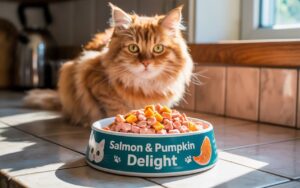
I created Salmon & Pumpkin Delight for my cat, which is home -made food or supplemental food. Salmon and Pumpkin are usually safe and beneficial material for cats. However, some important things should be kept in mind when preparing a homemade cat meal. more about Best cat food recipes with fish
How to make a Cat houses for outside diy
Do you want to build a cat houses for outside diy ? This is a very good decision. Outdoor shelters protect your cat from bad weather such as cold, rain or excessive heat. Building a house outside is a good and creative solution for professionals who want to meet the needs of stray and wild cats. This type of house keeps your pet safe from predators, ensures a safe and comfortable shelter for weak cats. If you build such an outdoor shelter for your pet, you will avoid annoying situations or territorial problems and will create a harmonious, pleasant environment for your cat.
Why We Recommend Using a Premix Supplement
Creating nutritionally balanced cat food at home can be challenging. Even with high-quality meats, organs, and bones, it’s easy to miss vital nutrients—or include too much of something your cat doesn’t need. That’s where premix supplements, also known as meal enhancers, come into play.
Premixes are specifically formulated powders that you mix with fresh meat to ensure your cat gets a complete and balanced diet. While they aren’t a magical fix, they make things easier and improve safety—especially if you’re not a veterinary nutrition specialist.
Here’s what you should look for when choosing a premix:
Formulated by a Veterinary Nutritionist
Certified veterinarians learn to identify and manage health issues in small animals, yet many veterinary courses offer minimal focus on animal nutrition. A recipe created by a veterinarian is a good beginning, but one designed by a board-certified veterinary nutritionist is superior.
Provides Complete and Balanced Nutrition
Examine the details closely to see if the premix meets AAFCO or FEDIAF nutrient standards. Certain products are designed solely for supplemental feeding, while others necessitate the inclusion of eggs, liver, or other components to address nutritional deficiencies.
Consider Specialized Formulas
Certain premix companies provide various formulas for cats at different life stages or with particular dietary needs. For instance, a formulation designed for older cats may contain reduced phosphorus to aid kidney function.
Consider the Type of Diet You’re Feeding
Numerous meal replacements are designed to be combined with minced or diced meat. These products can have increased calcium levels compared to premixes formulated for a blend of ground meat and bone. Choose the type of diet you wish to provide and pick a product designed specifically for that diet.


